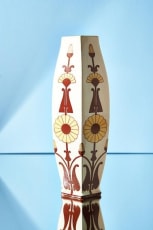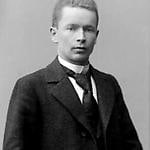

Founded as a subsidiary of the Swedish ceramics firm, Rörstrand, Arabia began by manufacturing traditional porcelain and earthenware, largely for export. Before 1900, in order to create a recognizable Finnish style, the firm commissioned leading architects, possibly including Eliel Saarinen (pictured), to contribute designs. The result was the Fennia range, with its patterns of Finno-Ugric origin. Technicians used copperplate prints to create the outlines, and artists filled them in by hand. In 1873, the Swedish company Rörstrand decided to develop the potentially profitable Russian market. To do so, the company sought and received permission to open a subsidiary in Finland in November 1873. This would give Rörstrand the financial advantage of Finland's lower export duties and shorter (thus more economical) shipping distances to Russia. The company's Finnish buildings were erected in 1874 on a plot of land known as Arabia on the northern outskirts of Helsinki.
The factory, was named for its location, was staffed with skilled workers from Sweden and a supplementary crew of talented Finnish craftsmen, which grew steadily in size and skill in the decades to come. Arabia's collection won a gold medal at the Paris World Fair in 1900. But soon afterward, in an effort to keep up with the times and to reach new markets, its product range again underwent major changes. At a time when many European nations endeavored to establish unique identities through the arts, Arabia introduced patriotic themes and Art Nouveau designs. The effort reached its peak with the introduction of the Fennia range in 1902.
In 1900, an American importer, Mr. Samuel, had ordered a collection to be designed for the north American market by one or several famous Finnish artists. The roster of possibilities includes Gezelius, Lindgren, Saarinen, Gallén-Kallela, and staff member Johan Jacob Ahrenberg. The first collection consisted of 16 vase models and an equal number of surface designs. By 1914 there were about 30 models in use. The decorations, all of Finno-Ugric origin, were created by applying outlines with copper-plate prints, then hand-painting within the outlines. Decorations tend to be geometric or highly stylized patterns on off-white backgrounds, painted in the bright colors often seen in Finnish folk art. This highly successful series was in production until the beginning of the 1920s. Fennia's geometric and stylized floral designs, in a palette that included dark blue, chartreuse, and red, recall folk embroidery and woven textiles. Off-white glazed ceramic vases were the vehicles for the designs. Some were simple bottle shapes. Others, while they were symmetrical without exception, were complex compositions of geometric solids showing an affinity for Finnish architectural embellishments.
Although Arabia has changed a great deal since the 1920s, the company continues to produce innovative ceramic wares and to attract an international clientele. At the same time, interest in Arabia's innovative work of the early 20th century continues to grow in North America and throughout the world.